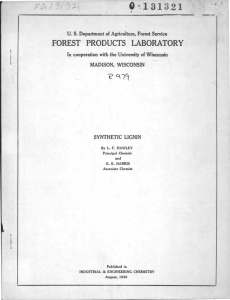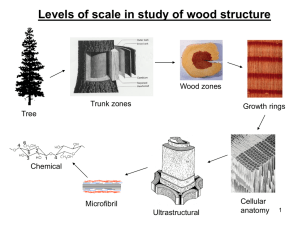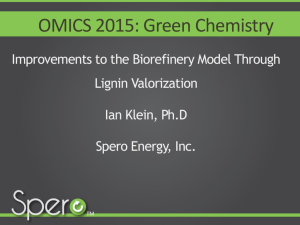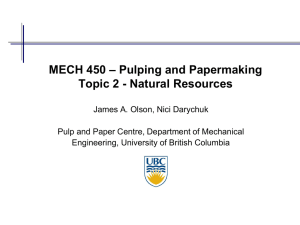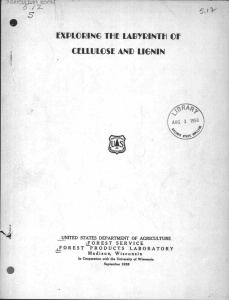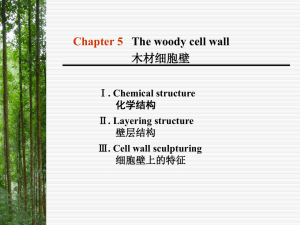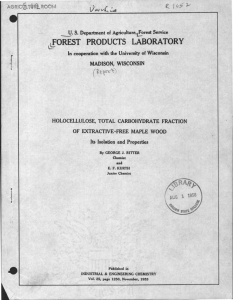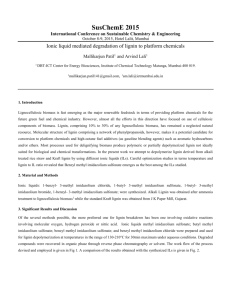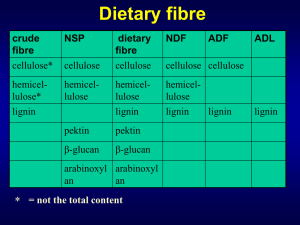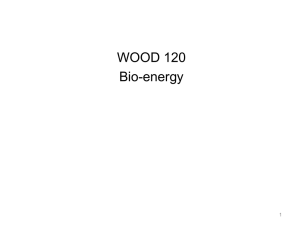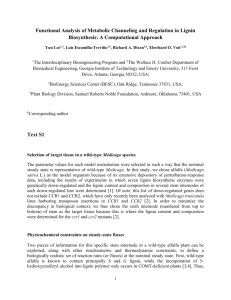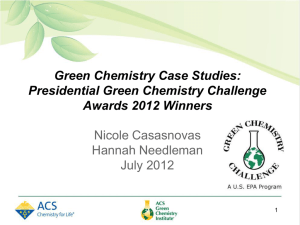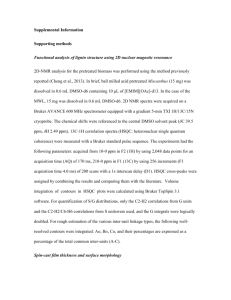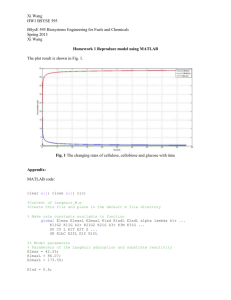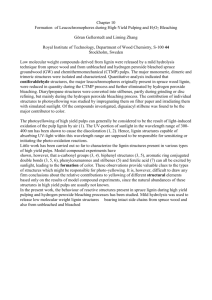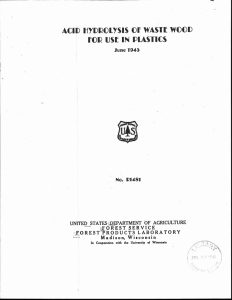Chapter Four Chemical components of wood
advertisement
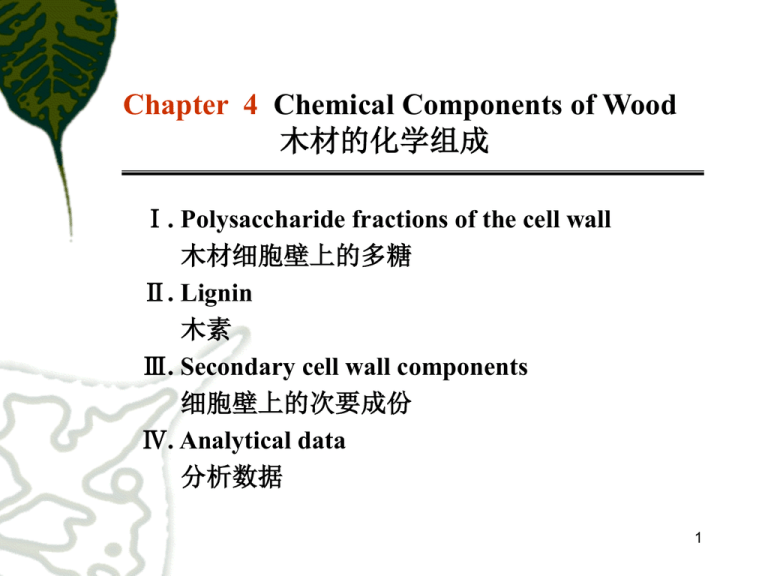
Chapter 4 Chemical Components of Wood 木材的化学组成 Ⅰ. Polysaccharide fractions of the cell wall 木材细胞壁上的多糖 Ⅱ. Lignin 木素 Ⅲ. Secondary cell wall components 细胞壁上的次要成份 Ⅳ. Analytical data 分析数据 1 All properties of wood arise from the nature and organization of the chemical compounds. Schematic Classification of the Chemical Components of Cell Wall Substance in Normal Wood (Percentages Based on Ovendry Weight) Ⅰ. Primary components A. Total polysaccharide fractions, expressed as holocellulose—60-85% 1. Cellulose—40-50% Long-chain polymer with low solubility 2. Hemicellulose—20-35% Noncellulosic polysaccharides; these are readily soluble in dilute alkali and hydrolysable by dilute acids to component sugars and uronic acids B. Ⅱ. Lignin—15-30% Secondary components A. Tannins B. Volatile oils and resins C. Gum, latex, alkaloids, and other complex organic compounds including dyes and coloring materials D. Ash—usually less than 1% 2 Ⅰ. Polysaccharide fractions of the cell wall 木材细胞壁上的多糖 The polysaccharide materials are separated into two fractions by treatment with dilute alkali: • The insoluble fraction — cellulose(纤维素) • The soluble fraction — hemicelluloses(半纤维素) • The combined cellulose and hemicelluloses in wood may be expressed as the holocellulose(全纤维素) 3 1. Cellulose / 纤维素 Cellulose is the most important single component in the woody cell wall in terms of its volume and its effect on the characteristics of wood. 1-1 Molecular formula: (C6H10O5)n, n =10000~15000 1-2 Structural formula: 4 1-3 Characteristics of cellulose structure • Linear polymers composed by D-glucose units, through βoxygen linkage between 1- 4 carbon. • Can be degraded into glucoses through hydrolysis, pyrolysis, and enzyme. • There is one –OH group on C2, C3 and C6 respectively, so it could suffer chemical reactions such as oxidization(氧化), etherification(醚化) and esterification(酯化). • There is a concealed –CHO at one end, so the molecule bears direction and polarity. 5 1-4 crystalline structure(结晶结构) Cellulose in woody cell walls occurs in a crystalline form. Crystalline area Non-crystalline area • Microfibril structure • Crystallite structure (晶胞结构) Parameters: a, b, c, β. One cellulose chain in the center and one on each corner . The center chain oriented in opposite direction to those on the corner, and is one half of glucose unit ahead of those on the corner. Chain units contained in each crystallite (4*1/4+1)=2 6 1-5 Supermolecular structure 40 cellulose chains →Elementary fibril 16 elementary fibrils →microfibril 4 microfibrils → macrofibril Several macrofibrils →lamella Several lamellas → cell wall 7 2. Hemicelluloses / 半纤维素 2-1 Sugar types in hemicellulses xylose, arabinose, galactose, mannose, glucose 2-2 Plane structure of hemicelluloses 2-3 Degree of polymerization: n = 150~200 2-4 Chemical properties : much more active than cellulose 8 Ⅱ. Lignin / 木素 1. Chemical structure of lignin • Basic units: phenylpropane • Linkages: C-O-C, C-C • With 3-dimensional structure (cellulose 1 , hemicelluloses 2) 2. Function of lignin • In the living tree, glue microfibrils and cells together to form walls. • In fiber board, glue wood fibers together to form boards. 9 3. Lignin types in softwood and hardwood • Softwood : composed of mainly guaiacyl units and a few Phydroxyl phenylpropane • Hardwood: composed of mainly syringyl and guaiacyl units, and a few p-hydroxyl phenylpropane. C C C C C C C C C C C C C C C H3CO OCH3 OCH3 OCHH3 3CO OH OH OH guaiacyl- C C C C C C C C C OCH3 OCH3 OCH3 H CO 3 OH OH OH OH OH syringyl- C C C OH para-hydroxyl-phenylpropane 10 4. Distribution in the cell walls • In compound middle lamella (PMP) lignin content in PMP: ~ 80% the amount in PMP: ~ 20% of the total amount in cell wall • In the secondary walls (S-wall) lignin content in S-walls: ~ 25% the amount in S-walls: ~ 80% of the total amount in cell wall 11 5. The thermoplastic nature of lignin The thermoplastic temperature of lignin : Softwood lignin : 170-175oC Hardwood lignin : 160-165oC 6. The Maule reaction of lignin The Maule test involves treatment with chlorine, followed by a weak base, such as ammonia. A red color is produced in hardwoods and a pale brown color in most softwood. The Maule reaction can be used to distinguish wood chips or powder of softwood and hardwood. 12 Ⅲ. Secondary components in wood 1. Extraneous materials / 抽提物质 • Location:in cell lumens • Content: 1-40% • Types: Wood extractives represent an extremely wide range of classes of organic compounds. polyphenols(多酚类): tannis(单宁), flavones(黄酮) oleoresin(含油树脂): turpentine(松节油), rosin(松香) other types: gums, fats, fatty acids, waxes • Effects to wood properties: Color, odor, weight, permeability, shrinkage, durability, painting and gluing. 13 2. Ash content / 灰分含量 • The ash content is normally 0.1 to 0.5percent of the oven dry weight of wood , but it may be much greater. • The alkaline earths, i.e., calcium, potassium, and magnesium, usually account for 70 percent of the total ash present. • Silicon occurs only in certain groups of trees and may amount to more than 2 percent of the dry weight of wood. The presence of silica in amounts less than 0.5 percent dry weight of wood will cause marked dulling of machine tools. • Those inorganic elements may be present in wood as components of the extractives or in the form of crystals. • Most crystals in wood are some form of calcium oxalate of various shapes and sizes. 14 Ⅳ. Analytical data 分析数据 In general terms, the chemical composition of wood on an oven dry basis can be summarized as: Cellulose: 40 - 50% Hemicelluloses: 20 - 35% Lignin: 15 - 35% Extractives: 1 – 40% Ash (inorganic components) : < 1% 15 Reflection and practice: 1. Chemical composition of wood? 2. Chemical structure of cellulose? 3. Main differences between cellulose and hemi-celluloses? 4. Chemical structure of lignin? 5. The thermoplastic nature of lignin and its function in a tree and in fiberboard? 6. Maule action and its mechanism? 7. Structural difference of lignin in softwoods and hardwoods? 8. What is holocellulose? 16
